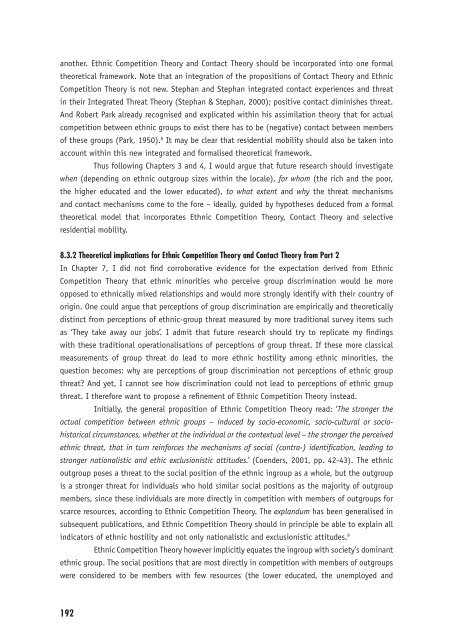Ethnic Hostility among Ethnic Majority and Minority Groups
Ethnic Hostility among Ethnic Majority and Minority Groups
Ethnic Hostility among Ethnic Majority and Minority Groups
You also want an ePaper? Increase the reach of your titles
YUMPU automatically turns print PDFs into web optimized ePapers that Google loves.
another. <strong>Ethnic</strong> Competition Theory <strong>and</strong> Contact Theory should be incorporated into one formal<br />
theoretical framework. Note that an integration of the propositions of Contact Theory <strong>and</strong> <strong>Ethnic</strong><br />
Competition Theory is not new. Stephan <strong>and</strong> Stephan integrated contact experiences <strong>and</strong> threat<br />
in their Integrated Threat Theory (Stephan & Stephan, 2000); positive contact diminishes threat.<br />
And Robert Park already recognised <strong>and</strong> explicated within his assimilation theory that for actual<br />
competition between ethnic groups to exist there has to be (negative) contact between members<br />
of these groups (Park, 1950). 8 It may be clear that residential mobility should also be taken into<br />
account within this new integrated <strong>and</strong> formalised theoretical framework.<br />
Thus following Chapters 3 <strong>and</strong> 4, I would argue that future research should investigate<br />
when (depending on ethnic outgroup sizes within the locale), for whom (the rich <strong>and</strong> the poor,<br />
the higher educated <strong>and</strong> the lower educated), to what extent <strong>and</strong> why the threat mechanisms<br />
<strong>and</strong> contact mechanisms come to the fore – ideally, guided by hypotheses deduced from a formal<br />
theoretical model that incorporates <strong>Ethnic</strong> Competition Theory, Contact Theory <strong>and</strong> selective<br />
residential mobility.<br />
8.3.2 Theoretical implications for <strong>Ethnic</strong> Competition Theory <strong>and</strong> Contact Theory from Part 2<br />
In Chapter 7, I did not fi nd corroborative evidence for the expectation derived from <strong>Ethnic</strong><br />
Competition Theory that ethnic minorities who perceive group discrimination would be more<br />
opposed to ethnically mixed relationships <strong>and</strong> would more strongly identify with their country of<br />
origin. One could argue that perceptions of group discrimination are empirically <strong>and</strong> theoretically<br />
distinct from perceptions of ethnic-group threat measured by more traditional survey items such<br />
as ‘They take away our jobs’. I admit that future research should try to replicate my fi ndings<br />
with these traditional operationalisations of perceptions of group threat. If these more classical<br />
measurements of group threat do lead to more ethnic hostility <strong>among</strong> ethnic minorities, the<br />
question becomes: why are perceptions of group discrimination not perceptions of ethnic group<br />
threat? And yet, I cannot see how discrimination could not lead to perceptions of ethnic group<br />
threat. I therefore want to propose a refi nement of <strong>Ethnic</strong> Competition Theory instead.<br />
Initially, the general proposition of <strong>Ethnic</strong> Competition Theory read: ‘The stronger the<br />
actual competition between ethnic groups – induced by socio-economic, socio-cultural or sociohistorical<br />
circumstances, whether at the individual or the contextual level – the stronger the perceived<br />
ethnic threat, that in turn reinforces the mechanisms of social (contra-) identifi cation, leading to<br />
stronger nationalistic <strong>and</strong> ethic exclusionistic attitudes.’ (Coenders, 2001, pp. 42-43). The ethnic<br />
outgroup poses a threat to the social position of the ethnic ingroup as a whole, but the outgroup<br />
is a stronger threat for individuals who hold similar social positions as the majority of outgroup<br />
members, since these individuals are more directly in competition with members of outgroups for<br />
scarce resources, according to <strong>Ethnic</strong> Competition Theory. The expl<strong>and</strong>um has been generalised in<br />
subsequent publications, <strong>and</strong> <strong>Ethnic</strong> Competition Theory should in principle be able to explain all<br />
indicators of ethnic hostility <strong>and</strong> not only nationalistic <strong>and</strong> exclusionistic attitudes. 9<br />
<strong>Ethnic</strong> Competition Theory however implicitly equates the ingroup with society’s dominant<br />
ethnic group. The social positions that are most directly in competition with members of outgroups<br />
were considered to be members with few resources (the lower educated, the unemployed <strong>and</strong><br />
192












